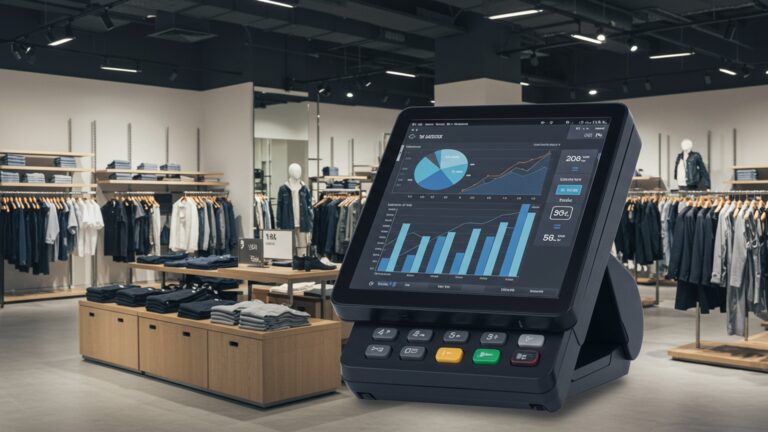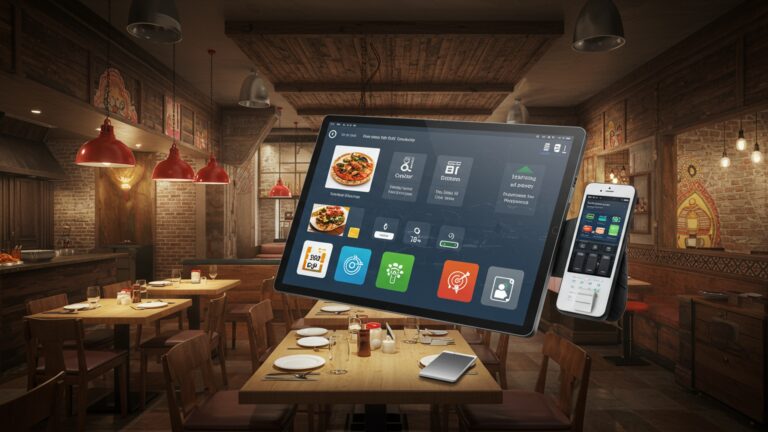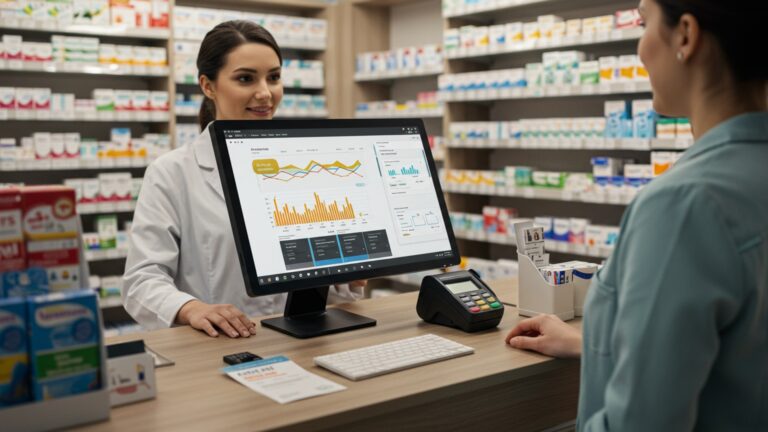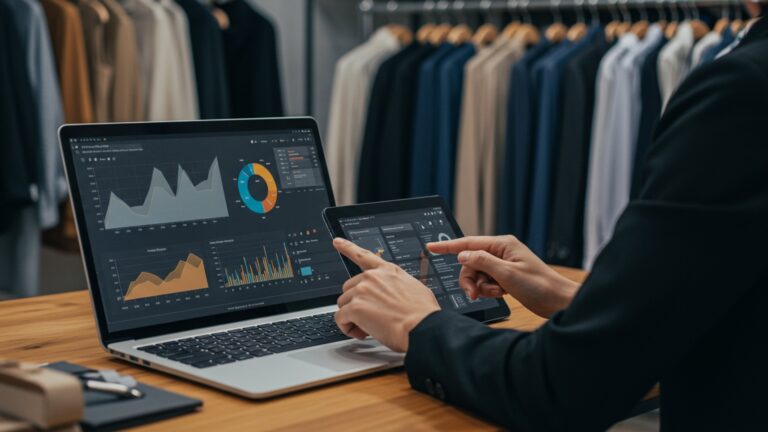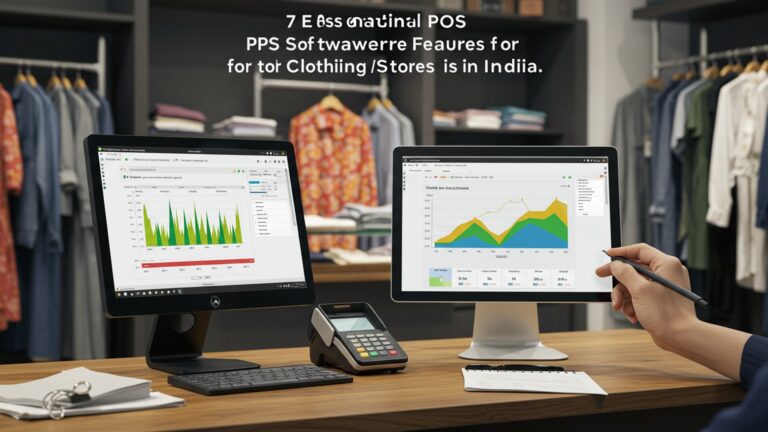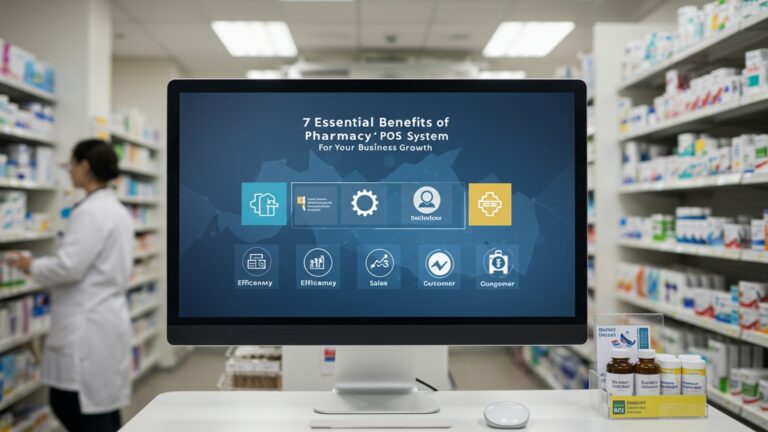7 Essential Features for a Multi Outlet Clothing POS System
Operating a multi-outlet clothing business presents unique challenges, from maintaining consistent inventory across diverse locations to delivering a seamless omnichannel customer experience. A robust multi outlet clothing POS system transforms these complexities into competitive advantages. Modern retailers demand real-time stock visibility for features like Buy Online, Pick Up In Store (BOPIS), centralized customer profiles driving personalized recommendations. unified sales data for dynamic merchandising decisions. Such a system acts as the central nervous system, ensuring operational fluidity and empowering strategic growth in today’s fast-paced fashion retail landscape.
Written by PromotoAI
promotoai generate content that ranks 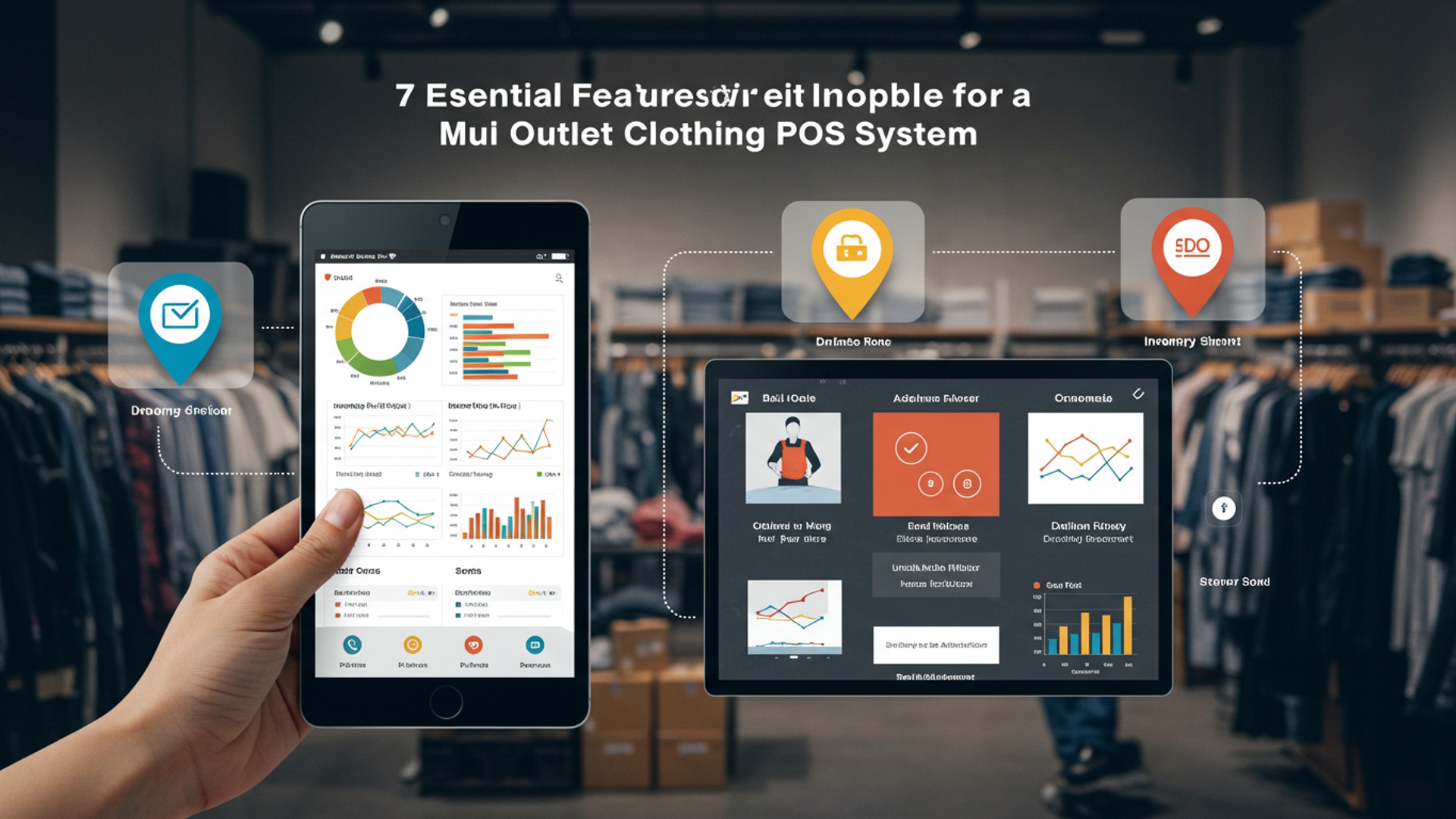
1. Centralized Inventory Management Across All Outlets
For any clothing retailer operating multiple stores, the ability to manage stock from a single, unified platform is not just a convenience—it’s a necessity. A robust multi outlet clothing POS system must offer centralized inventory management. This feature ensures real-time visibility into stock levels across all your physical locations and, ideally, your e-commerce channels.
Instead of separate, siloed inventories for each store, all product data resides in one central database. When a T-shirt sells in your downtown boutique, the system instantly updates its availability not just for that store. for every other outlet and your online shop.
- Real-time Stock Visibility
- Inter-Store Transfers
- Automated Reordering
- Unified Product Catalog
Know exactly how many units of a specific SKU (Stock Keeping Unit) are available at any given moment. in which store. This prevents overselling and helps in quickly locating items for customers.
Easily move stock between stores based on demand, reducing the need for markdowns in overstocked locations and fulfilling customer requests from understocked ones. For instance, if a customer in Store A wants a size that’s only available in Store C, the system facilitates the transfer or even a direct ship-from-store.
Set minimum stock levels to trigger automated purchase orders to suppliers, ensuring popular items are always in stock without manual oversight for each store.
Manage product details, pricing, images. descriptions from one place, ensuring consistency across all sales channels.
Imagine a popular seasonal dress. With centralized inventory, you can see that Store A has 10 units, Store B has 5. your online store has 15. If Store A sells out, a customer can still be served by checking Store B’s stock or placing an online order for fulfillment from Store C, all managed seamlessly by your multi outlet clothing POS system.
2. Robust Sales Reporting and Analytics
Understanding your sales performance is paramount for growth, especially when managing multiple outlets. An essential feature for a multi outlet clothing POS system is comprehensive sales reporting and analytics capabilities. This goes beyond just tracking daily sales; it offers deep insights into trends, customer behavior. store performance.
The system collects vast amounts of transactional data and transforms it into actionable reports and visual dashboards. This allows you to identify patterns, strengths. weaknesses across your entire retail operation.
- Multi-Store Performance Comparison
- Product Performance Analysis
- Employee Sales Performance
- Peak Hours and Seasonal Trends
- Customizable Reports
Easily compare sales figures, average transaction values. conversion rates between your different store locations. This helps identify top-performing stores and areas where improvements are needed.
Pinpoint your best-selling items, slowest movers. most profitable categories across all outlets or by individual store. This data is invaluable for future buying decisions.
Track individual employee sales, average sales per hour. commission calculations, fostering healthy competition and identifying training needs.
grasp when your stores are busiest, allowing for optimized staffing schedules and targeted promotions during specific times or seasons.
The ability to generate custom reports based on specific criteria (e. g. , sales of specific brands, discount effectiveness) gives you unparalleled flexibility in data analysis.
By leveraging detailed analytics, a clothing retailer can discover that denim sales spike significantly in your suburban outlets but remain steady in urban ones. This insight allows you to adjust stock levels, marketing efforts. even staffing for each location accordingly, maximizing profitability across your entire chain.
3. Integrated Customer Relationship Management (CRM)
In the competitive clothing retail landscape, building lasting customer relationships is key. A sophisticated multi outlet clothing POS system integrates CRM functionalities, allowing you to comprehend, engage. retain your customers across all touchpoints.
Beyond just processing transactions, the POS system acts as a central repository for customer data, including purchase history, preferences, contact details. loyalty program participation. This data is accessible to any store or online channel.
- Unified Customer Profiles
- Loyalty Programs and Rewards
- Personalized Marketing
- Returns and Exchanges Management
- Customer Feedback Collection
Create a single customer profile that captures all interactions, regardless of which store or online channel they shopped through. This means a customer’s purchase in Store A is visible if they visit Store B.
Implement and manage loyalty points, tiered rewards. exclusive discounts that are consistent and redeemable across all your outlets. This encourages repeat business.
Use purchase history and preferences to segment customers and send targeted promotions, such as discounts on their favorite brands or notifications about new arrivals that match their style.
Facilitate hassle-free returns and exchanges at any store, even if the original purchase was made at a different location or online, by quickly accessing the customer’s transaction history.
Integrate tools to gather feedback, helping you comprehend customer satisfaction levels and areas for improvement across your brand.
A customer buys a jacket from your online store. A month later, they visit your physical outlet in another city and receive a personalized discount offer for a matching accessory, based on their previous purchase history retrieved by the POS system. This seamless, personalized experience strengthens customer loyalty.
4. Employee Management and Performance Tracking
Managing staff across multiple locations can be complex. A comprehensive multi outlet clothing POS system simplifies employee management by providing tools to track performance, manage access. streamline scheduling across your entire retail operation.
The system helps you oversee your workforce efficiently, ensuring accountability and optimizing productivity, regardless of where your employees are stationed.
- Role-Based Access Control
- Time and Attendance Tracking
- Individual Sales Performance
- Commission Management
- Centralized Employee Database
Define specific permissions for different employee roles (e. g. , cashier, manager, store owner) to ensure data security and prevent unauthorized actions. A cashier might only have access to sales functions, while a manager can manage inventory and discounts.
Employees can clock in and out directly through the POS system, simplifying payroll processing and providing accurate records of hours worked for each location.
Monitor sales figures and metrics for each employee, allowing you to identify top performers, offer incentives. provide targeted training. This is crucial for recognizing contributions across different stores.
Automate the calculation of commissions based on sales, ensuring fair and accurate payouts for your sales team.
Maintain all employee insights, including contact details, roles. performance history, in one accessible location for all managers.
Role-Based Access Control (RBAC) is a method of restricting system access to authorized users based on their role within an organization. For a POS system, this means a junior associate can process sales but cannot access sensitive reports or change product pricing, which only a manager or owner can do.
5. Multi-Store Pricing and Promotions Management
Maintaining competitive and consistent pricing, while also offering targeted promotions, is a delicate balance for multi-outlet clothing retailers. A sophisticated multi outlet clothing POS system provides the flexibility to manage pricing and promotions effectively across all your stores.
You can implement global pricing strategies, regional variations, or store-specific promotions from a central dashboard, ensuring consistency where needed and flexibility where desired.
- Global Pricing Control
- Regional or Store-Specific Pricing
- Centralized Promotion Management
- Discount Code and Coupon Management
- Happy Hour or Flash Sale Configuration
Update prices for specific products or entire categories across all your stores simultaneously, ensuring uniformity and saving significant time.
Implement different pricing strategies for specific locations based on local market conditions, demographics, or competitive landscapes. For example, higher prices in a prime urban location versus an outlet store.
Create, schedule. manage promotions (e. g. , “Buy One Get One Free,” percentage discounts, bundle deals) that can be applied to all stores, selected stores, or even specific products within stores.
Generate and track discount codes that can be used online or in-store, with options for single-use, multi-use, or expiry dates, all centrally managed.
Set up time-sensitive discounts that automatically activate and deactivate, ideal for driving traffic during off-peak hours or for special events.
| Feature Aspect | Basic POS System | Advanced Multi Outlet Clothing POS System |
|---|---|---|
| Pricing Updates | Manual updates per store, time-consuming. | Centralized updates across all stores instantly. |
| Promotions | Limited, often manual, inconsistent across stores. | Flexible, scheduled, store-specific, or global promotions. |
| Regional Variations | Difficult to implement or maintain. | Seamlessly supports different pricing for different regions. |
This feature empowers retailers to react quickly to market changes and drive sales through strategic, well-controlled promotional campaigns across their entire network.
6. Seamless E-commerce Integration
In today’s omnichannel retail environment, your physical stores and online presence must work in harmony. A truly effective multi outlet clothing POS system offers seamless integration with your e-commerce platform, creating a unified shopping experience for your customers and streamlined operations for your business.
Your online store and physical POS system share critical data, including inventory, customer insights. sales data, eliminating discrepancies and improving efficiency.
- Unified Inventory Management
- Centralized Customer Data
- Click-and-Collect (BOPIS)
- Ship-from-Store Capabilities
- Returns and Exchanges Across Channels
As discussed, this is paramount. When an item is sold online, its stock level is immediately updated in your physical stores. vice-versa, preventing overselling and ensuring accurate stock counts everywhere.
Customer profiles, purchase history. loyalty points accumulated online are accessible in-store. vice-versa. This allows for consistent customer service and personalized marketing across all channels.
Allow customers to buy online and pick up in store. The POS system facilitates the order fulfillment process, notifying staff when an order is ready for collection.
If your online store is out of stock, the system can identify which physical store has the item and facilitate shipping directly from that location, turning a potential lost sale into a fulfilled order.
A customer can purchase online and return or exchange the item at any physical store, or vice versa, thanks to unified transaction records.
E-commerce integration typically relies on APIs (Application Programming Interfaces). An API acts as a messenger between your POS system and your e-commerce platform (e. g. , Shopify, Magento), allowing them to “talk” to each other and exchange data in real-time or near real-time.
// Example of how an API might update inventory
// This is conceptual and simplified
function updateInventory(productId, quantity, outletId) { fetch('/api/pos/inventory/update', { method: 'POST', headers: { 'Content-Type': 'application/json', 'Authorization': 'Bearer YOUR_API_KEY' }, body: JSON. stringify({ productId: productId, quantity: quantity, outlet: outletId }) }). then(response => response. json()). then(data => console. log('Inventory updated:', data)). catch(error => console. error('Error updating inventory:', error));
}
// When an online sale occurs for product 'P123' with quantity 1
// The e-commerce platform would call the POS API
// updateInventory('P123', -1, 'OnlineStore');
This seamless integration is critical for delivering a consistent, modern shopping experience and maximizing sales opportunities.
7. Scalability and Cloud-Based Architecture
As your clothing business grows and potentially adds more outlets, your POS system must be able to grow with you. Scalability, particularly through a cloud-based architecture, is a non-negotiable feature for a future-proof multi outlet clothing POS system.
A cloud-based POS system stores all your data on remote servers accessible via the internet, rather than on local hardware in each store. This offers immense flexibility and reduces infrastructure costs.
- Easy Scalability
- Anywhere, Anytime Access
- Automatic Updates and Maintenance
- Data Security and Backup
- Reduced IT Costs
Adding a new store or expanding your product lines becomes a simple process. You don’t need to install new servers or complex software; just set up new terminals and access the existing cloud infrastructure.
Business owners and managers can access reports, manage inventory. oversee operations from any location with an internet connection, whether at home, on the go, or from another store.
The cloud provider handles all software updates, security patches. maintenance, ensuring your system is always running on the latest, most secure version without requiring IT staff at each store.
Reputable cloud providers offer robust security measures and automatic data backups, protecting your valuable business data from hardware failures, theft, or natural disasters.
Eliminates the need for expensive on-premise servers, their maintenance. dedicated IT personnel in each location, leading to significant cost savings.
A cloud-based architecture refers to a system where software applications and data are hosted on remote servers over the internet (“the cloud”) rather than on local servers or individual devices. Users access these applications and data via a web browser or a dedicated app.
A clothing brand with five stores decides to open two more in different cities. With a cloud-based multi outlet clothing POS system, they can set up the new stores’ POS terminals in a matter of hours, connect them to the central system. immediately have full access to inventory, customer. sales data without any complex IT infrastructure deployment.
Written by PromotoAI
promotoai generate content that ranks
Conclusion
Selecting the right POS system for your multi-outlet clothing business is more than just ticking boxes; it’s about laying a foundation for seamless operations and exceptional customer experiences. In my view, the true power lies in a system’s ability to unify inventory, sales. customer data across all your locations, eliminating the common headaches of stock discrepancies or inconsistent pricing. Imagine effortlessly managing your entire fashion empire, just like mastering your garment shop operations with top POS systems. The market is constantly evolving, with current trends emphasizing cloud-based accessibility and integrated analytics that provide actionable insights into customer behavior and sales performance. My personal tip? Don’t settle for a system that merely processes transactions; look for one that empowers you to make smarter business decisions and fosters customer loyalty by recognizing shoppers across every touchpoint. By prioritizing these essential features, you’re not just investing in software; you’re investing in a future where your brand thrives with efficiency and a cohesive customer journey. Embrace this transformative technology and watch your clothing business flourish, consistently delivering style and satisfaction across every single store.
More Articles
Master Your Garment Shop Operations with 7 Top POS Systems
7 Best POS Software Options to Boost Your Business Efficiency
Discover the 7 Best POS Software Solutions in India for Your Business
Learn 8 Smart Ways POS Software Streamlines Inventory Management
5 Essential Features Your POS Billing Software Needs for GST Compliance
Written by PromotoAI
promotoai generate content that ranks
FAQs
Why is having one inventory system for all my stores so crucial for a clothing business?
A centralized inventory system is a game-changer because it gives you a real-time view of stock across all your locations. No more guessing if that specific size or color is available at another branch, preventing lost sales and improving customer satisfaction. It also helps you manage transfers between stores efficiently and reduces overstocking or stockouts.
How does a good POS help me keep track of my customers better?
A robust POS system includes CRM features that let you build detailed customer profiles. You can track purchase history, preferences. even run loyalty programs. This means you can offer personalized recommendations, send targeted promotions. build stronger relationships, turning first-time shoppers into regulars.
What kind of insights can I get from the sales reports?
You’ll get a ton of valuable insights! Beyond basic sales figures, you can see which products are hot sellers, which stores perform best, peak shopping times. even employee performance. These analytics help you make smarter decisions about stock, staffing. marketing strategies across all your outlets.
Is managing multiple stores from one place really possible?
Absolutely! A great multi-outlet POS system is designed for just that. You can oversee all your locations from a single dashboard – manage prices, promotions, staff. inventory transfers, all without having to physically visit each store. It streamlines operations and gives you a holistic view of your entire business.
How does the POS make returns and exchanges less of a headache?
It simplifies everything. With a good system, processing returns and exchanges is quick and seamless, even if the item was purchased at a different branch. You can easily look up original transactions, verify stock. issue refunds or store credit, which makes customers happy and reduces administrative hassle for your staff.
Can this system help me manage my employees across different shops?
Yes, definitely. Many modern POS systems come with features for employee management. You can set up different user roles and permissions, track sales performance by individual staff members. even manage time clocks. This ensures accountability and helps you optimize your team’s efficiency across all your outlets.
What about connecting my online store with my physical shops?
That’s a key feature! A top-notch multi-outlet POS should integrate seamlessly with your e-commerce platform. This means your online and in-store inventory is synchronized, customer data is unified. sales figures from both channels are consolidated. It creates a consistent shopping experience for your customers and simplifies your backend operations.

